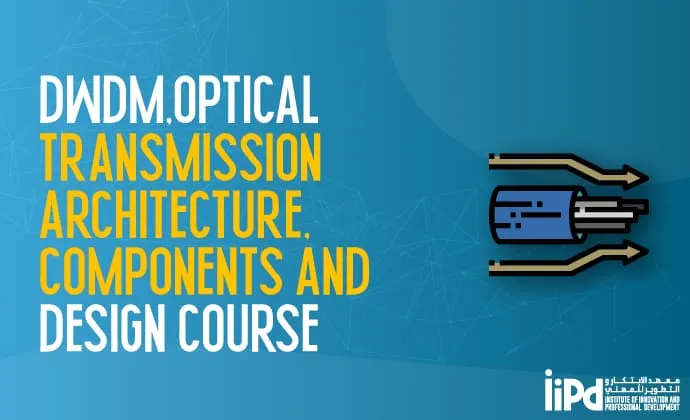
Course Details
Dense Wavelength Division Multiplexing (DWDM) is the key to the world’s telecommunications infrastructure, which has a huge transmission capacity.
DWDM systems allow much greater bandwidth than existing optical systems. Understanding this technology is critical for anyone involved with telecom and information technology.
In this course, the trainee will learn about the DWDM's network architectures, components, design, and Applications.
Target Audience:
This course is designed for Telecommunication, transmission engineers, designers, Operators, optical communications system installers, optical systems pre-sales, and consultants
Objectives:
Upon completing this course, the learner will be able to meet these overall objectives:
- Understanding the physics of the optical transmission
- Learn deeply the characteristics of fiber optics and fiber optic links
- Describe how the DWDM technology works
- Full Knowledge of the DWDM architectures and components
- Identify the Application of the DWDM
- Design the DWDM Systems
- Study actual cases with the latest technologies
Prerequisites:
Fiber Optic Basics
Contents:
Introduction & Fundamentals
- Basic Theories
- Why Optics?
- Optical Signal Fundamentals
- How the Fiber Optic Works?
- Fiber Optic Types & Standards
- Fiber Optic Connectors Types & Categories
- Fiber Optic Accessories
- Optical Transceivers SFPs
Optical Physics / Link Characteristics
- Attenuation
- Dispersion
- Insertion loss and reflection loss
- Absolute Optical Power
- Power Budget Calculation
- Loss Budget Calculation
- Fiber Optic Types, Choosing the proper Type
- Metropolitan & Long-haul Networks
Transmission Protocols
- Introduction to SONET and SDH
- Advantages of SDH over old protocols
- DM, PDH, and SDH
- SONET and SDH Hierarchy
- Transport Hierarchy
- SONET Protection Ring
- 2 Fibers and 4 Fibers
- OTN Protocol
Wavelength Division Multiplexing ( WDM )
- What is the Multiplexing and Why Multiplexing?
- Multiplexing Types
- WDM, CWDM, and DWDM
- Spectral Width
- Optical Windows
WDM site Components:
- Optical transponders.
- Optical filters.
- Solutions to overcomethe dispersion effect (DCM, coherent).
DWDM Architectures and Protection
- Unidirectional and Bidirectional DWDM
- Single Fiber Working
- OADM & ROADM
- CDC
- The ITU G.692 Grid
- Filter-less architecture
- Coherent DWDM
- Optical Cross-Connects (OXCs)
- Light Path Topology Design (LTD)
- Routing & Wavelength Assignment (RWA), Graph coloring
- Optical protection, reliability (MTBF, MTTR).
- Optical control and management
- Performance management, optical overhead.
- Optical Transport Network (OTN)
DWDM Passive Components
- RC
- Splitter
- Diffraction Grating
- FBG
- Thin Film Filter
- AWG
- Optical Isolator
- Mach-Zehnder interferometer
Lasers
- How laser work?
- LASERS Performance characteristics
- Laser Types
- Fiber Non-linearity
- Mode-locked lasers
- Laser vs. LED
Detectors
- How to Detect the Optical Signal?
- Types of Detectors
- Detectors Sensitivity
- Optical Wavelength Conversion
Optical Amplifier
- Repeater vs. Amplifier
- Amplifier Locations
- 1R, 2R & 3R
- EDFA
- DRA
Optical Switching
- O-E-O & O-O-O
- MEMS
- Liquid Crystal Switches
- Electro-Optical Switches
Modulation
- Signal formats
- Subcarrier modulation
- Optical channel capacity
- Demodulation: Shot/thermal noise; ideal signal detection
- Optical signal-to-noise, bit error rate
- Inter-symbol Interference (ISI)
- Coherent detection
- Dispersion Compensation
Advanced Routing and Switching
- WSS
- ASON
- GMPLS
- MPLS-TP
Hardware and Equipment Study Cases:
Ciena
- 6500 Platform
- 8180 Platform
- 5170 Platform
- Routing & Switching
- PTS
- SFPs
Nokia
- 1830 Versatile WDM Module
- Optical Anyhaul
- Wavelite
- SFPs
Huawei
- Optix OSN 9800 subracks
- 1830 Versatile WDM Module
- SFPs
- Review and Quiz
As technology continues to evolve, DWDM remains at the forefront of revolutionizing data transmission, making expertise in this field highly sought after. By enrolling in the DWDM Optical Transmission Architecture, Components, and Design Course at IIPD Global, you are positioning yourself to become a proficient professional capable of driving innovation in the field of optical communication.








